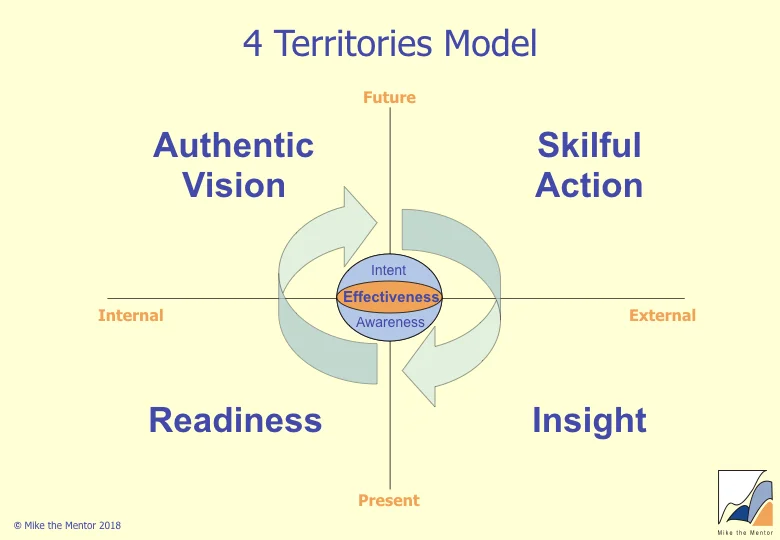Inner Game
/In the early 1970s Tim Gallwey, on a year's sabbatical from Harvard, was doing some tennis coaching at his local club. Noticing that players often improved their play despite his coaching rather than because of it, he became curious about how learning was actually taking place. He noticed was that there was an internal conversation going on in the player's head and he got curious as to who was speaking to whom! Gallwey labelled the part that was doing all the talking ("Get your racket back early", "That was a dumb shot", "Come on, concentrate", etc) Self 1 and the part being talked at Self 2.
In reflecting upon his own tennis game, Gallwey also noticed that when he was playing at his best, he wasn't trying to control his shots with self-instruction and evaluation. He expresses this experience of how he is able to play closer to his potential when the interference produced by this self-talk is reduced in the equation:
Potential - Interference = Performance, or:
This "inner game" of how to reduce the interferences that Self 1 generates which prevent us from being in the high performance flow states associated with Self 2 is what the Inner Game (IG) coach focuses on. One way of doing this is to give Self 1 something to do, as in the Smiley Faces story below.
This story also illustrates the key role of non-judgemental awareness which can, on its own, lead to learning and improved performance. Or, as Gallwey puts it, "Awareness is curative". To generate focussed awareness, you will often see an IG coach repeatedly asking the following sequence of questions: "What do you notice?", What else?", "Which of these is most interesting?". Successfully done this moves the coach into a state of focussed but relaxed concentration which leaves no space for Self 1 and so releases Self 2's potential. It also ensures that it is the client's interest, rather than the coach's agenda, that drives the coaching making this a highly non-directive form of coaching.
More in The Inner Game of Tennis, The Inner Game of Work: Overcoming Mental Obstacles for Maximum Performance, and at www.theinnergame.com
And if you haven't seen the classic video of Tim and Molly filmed by ABC TV in the 1970s in which she learns to play tennis (forehand, backhand and serve) in 20 minutes, have a look at this wonderful YouTube video. It's 9 minutes long and the best demonstration of rapid learning I've seen.
Smiley Faces
Here's a brilliant example of the Inner Game in action from the December 2000 issue of Fast Company magazine:
When my daughter Chelsea was eight, I coached her softball team. On one of the first days of practice, I have everyone try to do some batting. I take a really soft, spongy ball, and I toss it to the first girl. She's standing maybe 10 feet away, I'm throwing baby tosses, and she screams and hides her head. So I say, "Hey, no problem, Suzy. Go to the back of the line. That's fine. Betsy, you step up." Next girl in line. She does the same thing - buries her head and screams. So I'm realizing that this is going to be a really long practice if we don't do something different.
I go out to my car where I have my handy whiteboard markers in my briefcase. I take the bag of practice balls and draw four smiley faces - red, black, blue, and green - on each ball. When you look at a ball, all you see is one smiley face. I go back out and call the girls back over: "Okay. We're going to play a different game this time," I say. "This time, your job is to name the color of the smiley face. That's all you have to do."
So little Suzy stands up, and I toss a ball by her. She watches it all the way and goes, "Red." Next girl, Betsy, gets up there, Betsy goes, "Green." They're all just chirping with excitement because they can identify the color of the smiley face, so I say, "Okay. Now I want you to do the same thing, only this time I want you to hold the bat on your shoulder when the ball goes by." Same level of success. Excitement builds. The third time through, I ask them to touch the smiley face with the bat.
We beat our opponents 27 to 1 in the first game. I can't tell you how many Little League baseball games I have been to where parents and coaches are yelling at the boys, "Stand up straight. Hold up that bat elbow. Dig in that back foot. Rotate those hips." They're giving all kinds of detailed instructions to get the kids to change their actions - instead of doing what I did, which was to work hard on shifting the kids' perceptions. When you shift people's perceptions, their actions follow.

